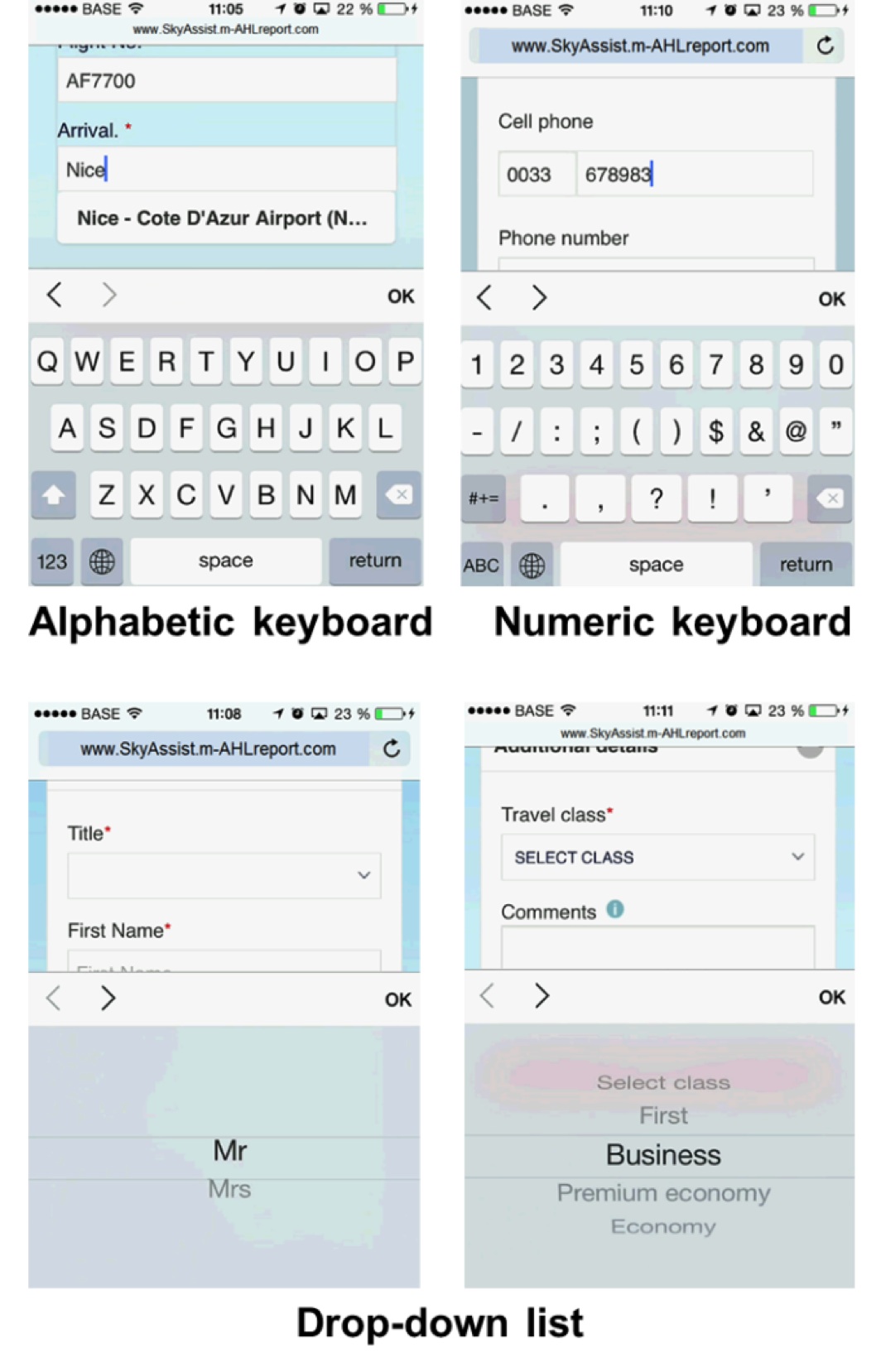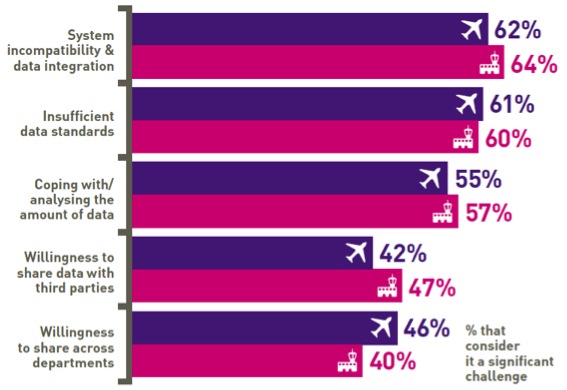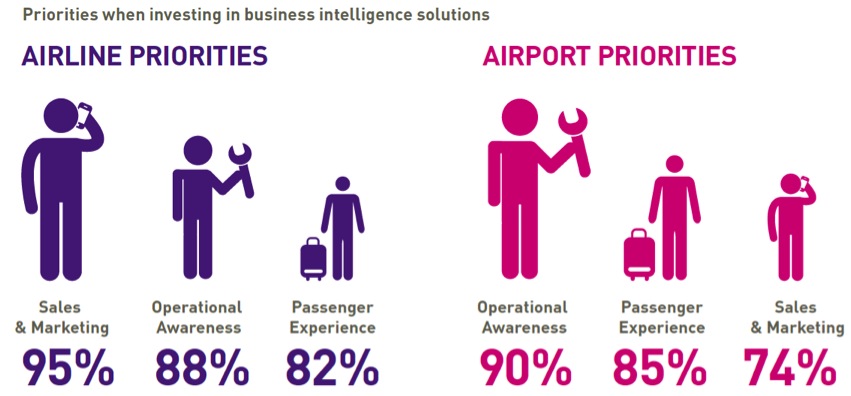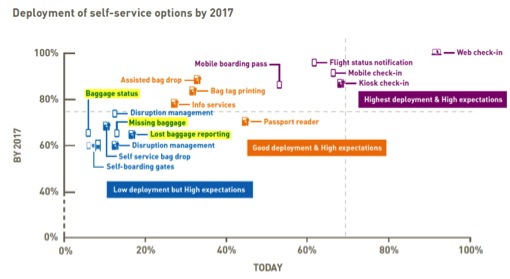m-AHLreport: offer passengers to declare their delayed bags on their smarphone
m-AHLreport is our new mobile application for passengers to declare their missing bags on their smartphone.
e-AHLreport is already used by several of our customers (Air France KLM, Swissport, SBA) for some years. During 2014 summer, in collaboration with Air France we developed the mobile version of e-AHLreport: m-AHLreport.
The process flow of m-AHLreport is based on the one of e-AHLreport. Passengers are navigating through 5 screens: welcome, flight, baggage information, personal details and summary screens.

Once the passenger has reviewed and validated the summary screen, the AHL file is directly created in WorldTracer with web-service connectivity. The passenger receives an e-mail with the PIR attached.

The screens have been adapted to fit on the smaller screens of smartphone and use mobile features such as integrated keyboard and native dropdown picker.

m-AHLreport is used in production within Air France mobile website since October 2014.
The Reclaim project at Brussels Airport
At Brussels airport, until recently passengers coming to pick-up their delayed baggage had to access the Lost & Found offices via the same way than the passengers exiting the arrival area. Passengers coming to pick-up their bag had to address a security agent with their AHL PIR. The security agent was contacting the relevant handler to ensure that this passenger was granted to the non-public zone of the arrival area. This process was not very convenient since:
Passengers were passing through the same corridor but going in two directions (to exit the arrival area and to enter the arrival area) causing practical and security issues.
Checking the eligibility of the passenger to enter the arrival area was taking time. It required the security agent to phone the appropriate handler who needed to check manually in BagAssist if the bag for this passenger had arrived.
The reclaim project, initiated in April 2014, aims at automating the security check at the Lost & Found entrance for passengers coming in with an AHL report. As from mid-October, the procedure is as follow.
When an AHL is created at Brussels Airport by any of the handler (Swissport, SBA or Brussels Airlines) a bar code is printed on the PIR. The barcode is present independently from the application used to report the delayed bag: BagAssist, kiosk-AHLreport or e-AHLreport.
Later when the bag is received at the airport, the passengers coming to pick-up their bag have a dedicated access, further away from the exit used by passengers leaving the arrival area.
The passenger scans the bar code on his AHL report.

The AHL file is retrieved from the bar code and it is checked in a database at Brussels Airports whether this passenger is eligible or not. The Brussels airport database is updated by a thread running on BagAssist database; thus the Brussels airport database always contains the latest status of the AHL files created in BRU station. The criteria to define passenger eligibility are:
Day of file creation: passenger can only use this gate within the primary tracing period.
Bag status: at least one bag has been received at the airport and has not been delivered or picked-up yet. The passenger is not eligible to enter the Lost & Found area in the following cases: the file is closed or no bag has been received yet or all bags have been handed to the passengers already or all bags have been FAH.
In case the passenger doesn’t have the printed AHL PIR with the bar code with him, he has two options:
Entering his file reference to get a printed bar code that he can scan at the gate.
Calling the relevant handler using a phone put outside of the gate.
The challenges of seamless travel
“A smooth and hassle-free journey where passengers do not have to break stride from the curb to the gate unless they choose to is the goal: that would deliver tremendous value to passengers.” explained Transport Association’s (IATA) Chief Executive Tony Tyler at its 2013 World Passenger Symposium (1).
To make seamless travel a reality, airline and airports will have to collect, manage and share in real-time key information about the passenger journey and about their own key assets (planes, security checkpoint, staff, etc.). Airlines and airports face several challenges to make the fullest use of the latest intelligence inherent in their operational and passenger systems.
SITA in its 2014 report “Smart thinking” (2) has listed the five most important challenges accoding to airlines and airports.
System incompatibility & data integration
The variety of the systems currently used by airports, ground-handlers and airlines brings complexity to the exchange of data. System compatibility is an unavoidable step for the implementation of business intelligence initiatives.
Insufficient data standards
Due to the high number of systems in use by the different stakeholders, data is likely to come from multiple sources making it more complex to get meaningful information. Standards and good practices should be put in place to ensure the data interoperability.
Coping with / analysing the amount of data
Within airports and airlines, an important amount of data is already retrieved and collected. Nevertheless the challenge lies in the meaningfulness of the information. To be exposed to the passengers or the staff, the data should be processed, analysed and communicated in a user-friendly manner.
Willingness to share data
Although stakeholders recognize the need for collaboration, reluctance to share data freely is a fact; whether this is a across departments of the same company of with third-parties. The ambitions to improve services and operations are dependent on the ability of stakeholders to overcome this stumbling block.
Finally, SITA raises another challenge: “While airlines and airports have broadly similar ambitions to create greater visibility around the passenger journey, there are key differences in their priorities for utilizing business intelligence.” Indeed, airlines give the highest priority to “Sales & marketing” whereas airports put the focus on “Operational awareness”.
1 – International Air Transport Association, Delivering More Value to Air Travelers, press release 29 October 2013.
2 – SITA, Report “Smart thinking”, published in 2014.
A boost in mobile usage?
The Airline IT Trends Survey of SITA forecasts a boost in mobile usage for the coming years.
By 2017 more than 90% of airlines will have deployed self-service mobile solutions for flight status notification, check-in and boarding passes. As for missing baggage management, 66% of airlines will have mobile solutions by then. If this forecast is confirmed, this means that between today and 2017 the number of airlines offering mobile applications for missing bag will be multiplied by 6.
Today, the self-service options (via kiosk or mobile) for baggage have a limited deployment (under 20%). Nevertheless there are high expectations for these applications: the planned deployment for 2017 is above 60%.
At Sky Assist we already anticipated this boost in mobile usage. Our self-service applications e-AHLreport (to create an AHL) and e-AHLmanage (to check an AHL status and update AHL) can already run on tablets such as iPad. Also we are working on a mobile version of e-AHLreport, but we’ll not say more for the moment and keep the surprise for our user conference in October!
BagAssist Suite in the world
Summer is a great season to travel! So we thought that we would make you travel by showing you where in the world BagAssist and the self-service applications are used. You will see that our BagAssist community is very international.
The below map shows you all the countries in which at least one station uses one product of the BagAssist Suite. Some stations use only BagAssist for agents or only the self-service applications, some other stations use both the agents and passengers solutions.
As most of the BagAssist community is located in Europe, we did a focus on Europe. We created a second map to list the European stations using BagAssist for agents (in this map self-service applications are not considered). BagAssist is used in most of the countries of Western Europe and is extremely present in France and Switzerland.
Of course BagAssist is well represented in the Brussels airport too where 100% of the handlers are using the BagAssist Suite. Also at Brussels airport, 5 kiosks are running our kiosk-AHLreport application for passengers to report their missing bags.